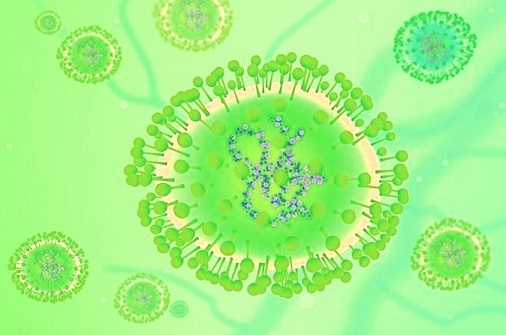Nikhil Prasad Fact checked by:Thailand Medical News Team Jan 10, 2025 3 months, 1 week, 11 hours, 8 minutes ago
Medical News: Human metapneumovirus (HMPV), a respiratory virus responsible for a significant number of infections worldwide, has long been a challenge for scientists seeking to understand its transmission mechanisms. Researchers from the University of Kentucky College of Medicine-USA, Universidad Autónoma de Chile, and other institutions have made significant progress in this area, uncovering how the virus exploits cellular structures to spread more effectively.
 Insights into How Human Metapneumovirus (HMPV) Spreads Between Cells
The Role of Filaments and Cellular Extensions in Viral Spread
Insights into How Human Metapneumovirus (HMPV) Spreads Between Cells
The Role of Filaments and Cellular Extensions in Viral Spread
HMPV belongs to the Pneumoviridae family and is known to cause respiratory illnesses, particularly in young children, the elderly, and individuals with weakened immune systems. While previous research has documented that HMPV spreads via both cell-free and direct cell-to-cell mechanisms, the exact processes enabling this transmission remained unclear. In response to this, the team conducted an extensive study employing advanced imaging technologies to uncover new insights into these mechanisms. This
Medical News report provides a detailed breakdown of their findings.
The study revealed that infected cells produce filamentous structures containing the viral genome, along with intercellular extensions that enable direct communication between cells. These filaments, enriched with HMPV’s fusion (F) protein, were observed budding from the surfaces of infected cells and making contact with neighboring cells. This contact facilitates the spread of viral components to uninfected cells, bypassing extracellular immune defenses.
Cellular Remodeling Induced by HMPV
Using techniques like scanning electron microscopy and live cell imaging, the researchers demonstrated how HMPV drastically alters cellular architecture. The virus induces the formation of long, filamentous extensions and shorter branching filaments. These structures were observed to change in size and morphology during the course of infection. For example, infected cells exhibited thinner and significantly longer extensions compared to uninfected ones, with some exceeding lengths of 40 micrometers. These extensions act as bridges for direct cell-to-cell transfer of viral components.
Moreover, the team discovered that HMPV’s F protein plays a critical role in forming these filaments. Immunogold labeling revealed that as infection progresses, the F protein localizes predominantly in the filaments, which eventually contact neighboring cells. Interestingly, these structures contain the viral genome but not the antigenome, suggesting that they represent budding virions ready for transmission.
Inclusion Bodies and Direct Cytoplasmic Transfer
A groundbreaking aspect of the study was the discovery of inclusion bodies (IBs) moving directly between cells via these extensions. IBs are liquid-like compartments within infected cells that house the viral replication machinery.
Through live cell imaging, researchers observed IBs traveling acros
s the intercellular extensions and entering neighboring cells, where they could potentially initiate a new cycle of infection.
The researchers used fluorescent dye experiments to confirm that HMPV-infected cells establish cytoplasmic communication with adjacent cells. Dye transfer was observed only in infected cells, indicating that these extensions enable selective transfer of viral material. This discovery underscores the virus’s ability to evade immune responses by directly spreading its genetic material from cell to cell.
Implications for Viral Transmission and Immune Evasion
The study’s findings highlight the efficiency of direct cell-to-cell spread as a viral transmission strategy. Unlike cell-free virions that must navigate extracellular barriers, direct transfer through intercellular extensions offers HMPV several advantages. These include faster dissemination, evasion of neutralizing antibodies, and higher infection efficiency due to the delivery of replication-ready IBs.
Additionally, the study suggests that this mode of transmission may be common among other viruses, including respiratory syncytial virus (RSV) and influenza. The use of similar filamentous structures and extensions has been observed in these viruses, hinting at shared evolutionary strategies.
Study Methodology and Collaboration
This research was a collaborative effort involving multiple institutions. The primary researchers included Farah El Najjar, Santiago Restrepo Castillo, and Rebecca Ellis Dutch from the University of Kentucky, as well as Nicolas Cifuentes-Munoz from Universidad Autónoma de Chile. Their work combined electron microscopy, fluorescence imaging, and molecular biology techniques to achieve these groundbreaking insights.
Cells infected with HMPV were studied under various conditions, and the dynamics of filament and IB formation were meticulously documented. Quantitative analyses revealed significant differences in the size and branching of filaments between infected and uninfected cells. Additionally, the study employed live imaging to track the movement of IBs across intercellular extensions in real time.
Conclusion
This study sheds new light on how HMPV spreads between cells, highlighting the crucial role of filamentous structures and intercellular extensions in its transmission. By bypassing extracellular immune defenses, the virus enhances its ability to infect host cells efficiently. The findings also provide a basis for further exploration of similar mechanisms in other viruses, potentially opening new avenues for antiviral therapies targeting direct cell-to-cell spread.
The research emphasizes the need for targeted strategies to disrupt these viral transmission pathways. Potential interventions could involve drugs that inhibit the formation of filaments or block the movement of IBs, thereby curbing the virus’s ability to propagate.
The study findings were published in the peer-reviewed journal: mBio.
https://www.sciencedirect.com/org/science/article/pii/S2150751123001296
For the latest HMPV News, keep on logging to Thailand
Medical News.
Read Also:
https://www.thailandmedical.news/news/human-metapneumovirus-hmpv-alters-actin-cytoskeleton-of-host-cells-to-enhance-direct-cell-to-cell-spread
https://www.thailandmedical.news/news/understanding-human-metapneumovirus-fusion-mechanism
https://www.thailandmedical.news/news/how-human-metapneumovirus-gains-entry-into-c
https://www.thailandmedical.news/news/human-metapneumovirus-mimic-human-rna-to-evade-immune-defenses
https://www.thailandmedical.news/articles/hmpv-human-metapneumovirus
